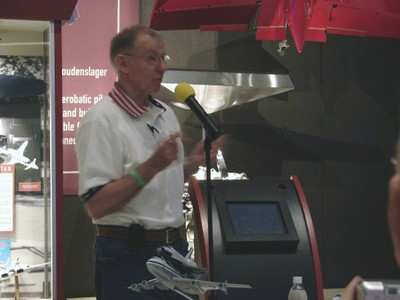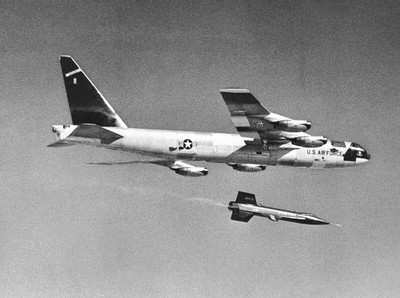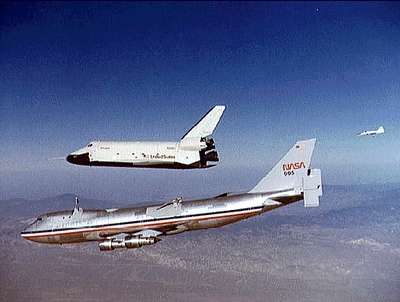Tells Of Adventures In X-15, Shuttle
by ANN Correspondent Chris Esposito
Major General Joe Engle detailed his adventures in the X-15 and
Space Shuttle Projects recently at AirVenture 2007. Engle -- who
has amassed 11,000 flight hours, 200 of which were in space -- flew
in the space shuttles Enterprise, Columbia, and Discovery. He
recounted the advances made with the two aircraft, as well as his
personal experiences in them.

The original X-15 used two sets of LR-11 rocket motors; each had
four separate chambers "like an over-under shotgun," explains
Engle. With a total of eight rocket chambers, the pilot could
ignite the fuel all at once, or in stages. The next evolution in
the X-15's motor, the LR-99, produced nearly 60,000 pounds of
thrust and pushed the X-15 to Mach 6.7. The shockwaves from this
speed run caused significant burning of the aircraft's stabilizers
and ventral fin, essentially "totaling" the aircraft.
Since there were no solid inertial platforms during the 1950s
and early 60s, pilots had to shut down the engine at very specific
times to ensure they could manage the X-15's energy enough to make
the landing zone, which was typically a dry lakebed. Controlling
the descent angle required "all eyeballs out the window." says
Engle.
With no approach path aids in the cockpit or at the landing
sight, judging distance and glide was very much on the pilot's
shoulders. Engle recalls the landing of the X-15 as "very
unnatural... No matter what you did with the stick, the nose would
slam down," he says.

Control was a problem at high altitudes, particularly after
150,000 feet. To solve this, the X-15's engineers designed two
control systems, one using reaction controls powered by oxygen
peroxide, and the other using the flight surfaces. Neither control
stick was put in the center, as the tremendous G's would mean
induced oscillations when the pilot accelerated or decelerated
sharply. When the Shuttle program began, the two control systems
were combined into one stick that was computer-controlled and would
automatically switch between the systems.
"The X-15 really prepared us to fly the Space Shuttle." explains
Engle. He described the X-15 program as "one of the most rewarding
things I've done in my career." The 300 knot patterns and 195 knot
landing speeds of the X-15 meant the test pilots would be
well-prepped for Shuttle missions. Engle flew the Shuttle on the
initial glide test flights, when the Shuttle was brought aloft by a
747. Originally, the engineers of the Space Shuttle considered
putting turbine engines in the payload bay, but discarded this idea
after the X-15's many successful flights under no power.

When the explosive bolts detonated, separating the Shuttle from
the 747, "we would pop off with pretty good G-force." Engle says.
Engle and another pilot would then climb and roll left to assure
adequate clearance during separation. Once gliding down, the pilots
gathered data on aerodynamics by flying at different angles of
attack. Engineers could then calculate lift/drag ratios for
different airspeeds and configurations.
As with the X-15, the initial Space Shuttle test flights
required pure skill, because the cockpit did not feature an
inertial platform for guidance.

"I'm sorry to see us stop flying the shuttle," says Engle,
referring to the planned retirement of the fleet in 2010. He
prefers the winged approach to spaceflight due to the "stick and
rudder" feel.
Looking to the future, Engle sees nuclear power as the only way
to extend our reach into the cosmos. The energy produced by such a
spacecraft would be "almost inexhaustible," he says.
 Airborne 07.02.25: TikToker Arrested, Vietnam A/L Ground Hit, ATC Modernization
Airborne 07.02.25: TikToker Arrested, Vietnam A/L Ground Hit, ATC Modernization Airborne Affordable Flyers 07.03.25: Sonex HW, BlackShape Gabriel, PRA Fly-In 25
Airborne Affordable Flyers 07.03.25: Sonex HW, BlackShape Gabriel, PRA Fly-In 25 ANN's Daily Aero-Term (07.07.25): Discrete Code
ANN's Daily Aero-Term (07.07.25): Discrete Code Classic Aero-TV: DeltaHawk Aero Engine Defies Convention
Classic Aero-TV: DeltaHawk Aero Engine Defies Convention ANN's Daily Aero-Linx (07.07.25)
ANN's Daily Aero-Linx (07.07.25)






